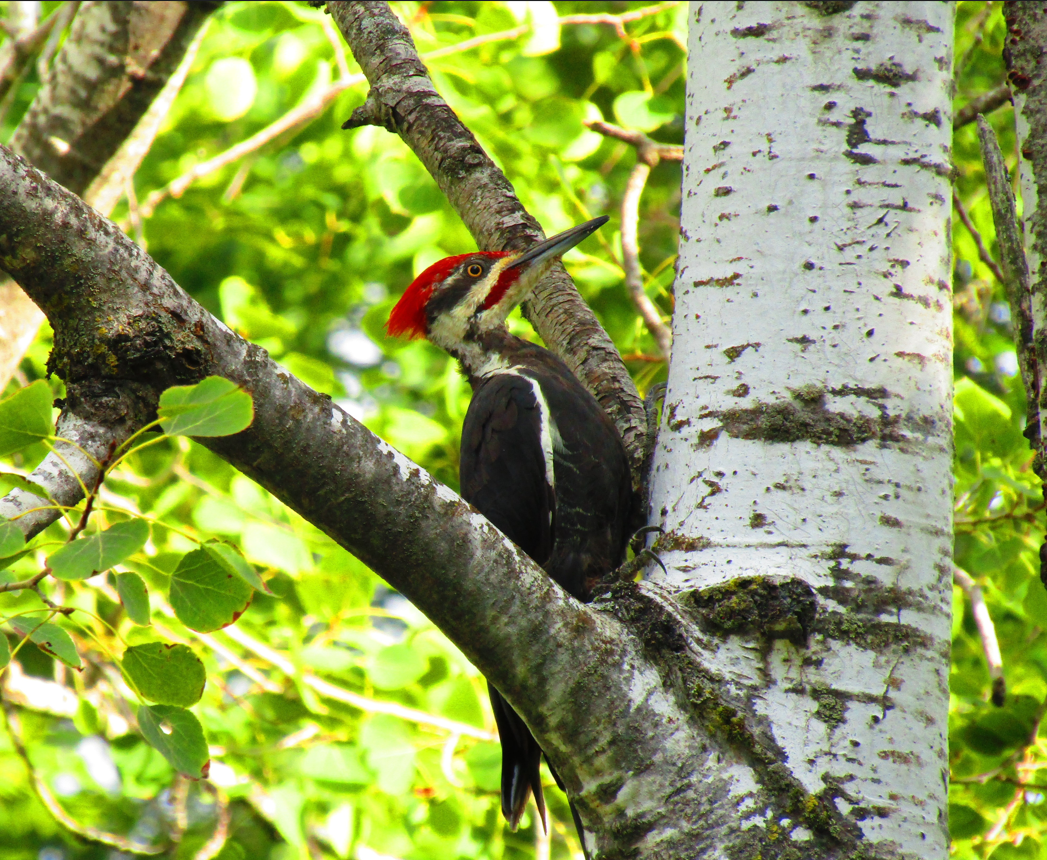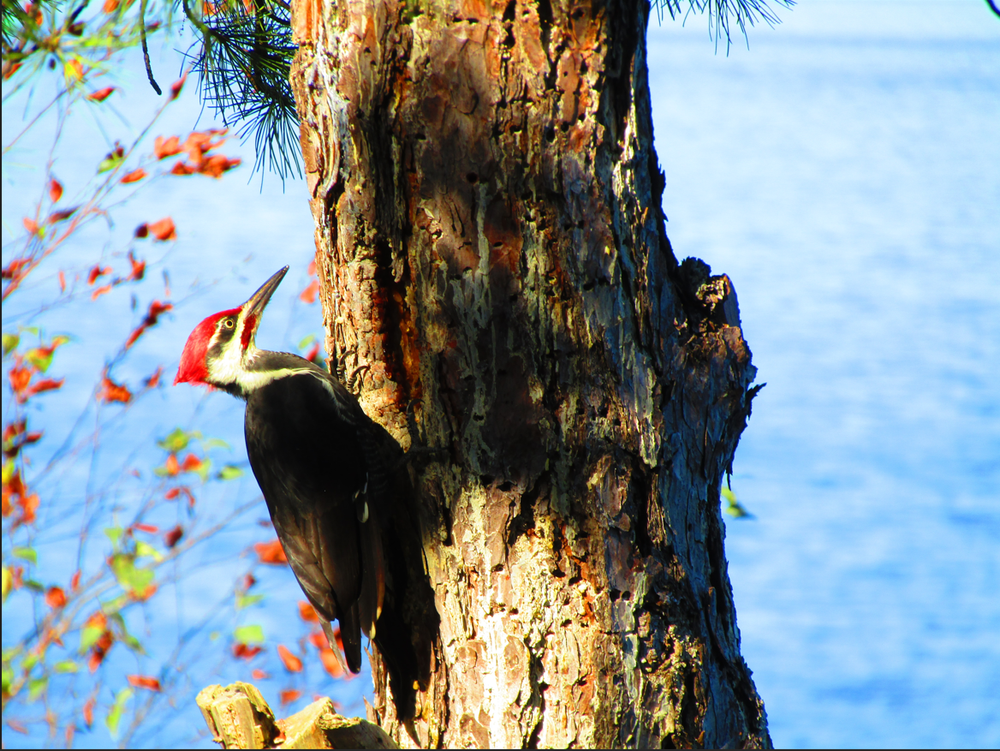The Drummer
by: Patty Mondore
It reminded me of a scene from Drumline or at least someone warming up for it. I heard the sound from inside our camp and knew he was lurking out there somewhere. But shortly after that, I heard the real concert begin. The call of the Pileated Woodpecker is not only distinctive but even sounds somewhat otherworldly, as if it belongs more in a tropic rain forest than in our backyard. But sure enough, as soon as I opened the door, I spotted him having his breakfast on a tree overlooking the River.
I wondered if, much like us, he enjoyed his meal better with waterfront seating. He paused only long enough to determine that I was an annoyance but not a threat and went back to his hammering. “Hey, easy on our tree, pal” I said since there was already a fairly large rectangular hole just above where he was dining this morning. Eventually, he had enough of my unsolicited commentary, and, with that iconic cackle, he flew off into the woods.
The Pileated Woodpecker is common here along the River, but is nevertheless a showstopper every time he makes an appearance. It is the largest woodpecker in the US (and Canada), ranging from 16 to over 19 inches (40 – 48 cm) tall. They are big, bold, and beautiful birds that are easily identified by a flaming red crest on their head, along with black wings and tail, white underwings, and black and white stripes on the face and neck.

Males also have a stripe of red on each cheek. The word “pileated” refers to the red crest and comes from the Latin pileatus, meaning “capped.” As for that call, Audubon.org says that “. . . their loud, escalating shrieks bring to mind a maniacal laugh . . .” I also saw someone appropriately refer to it as “Tarzan-like.” Audubon noted that the Pileated Woodpecker experienced huge population declines in the US during the 18th and 19th centuries, but that they started to recover in the 1920s due to state and federal protection, forest regrowth, and the woodpecker’s ability to adapt to urban areas.
Today, there are up to 2.6 million of these birds in North America. Pileated Woodpeckers nest mostly in standing dead trees. Their diet consists of carpenter ants, beetles, other insects, and occasionally fruits and nuts. Their appetite for bugs helps keep a forest healthy by eating wood-boring insects. They use their straw-like tongues to pull out beetle eggs. Their tongue is sticky, contains barbs, and is extremely long! In fact, the tongue is so long the bird wraps it in and around its skull when not in use.
They prefer to live in forests and wooded areas that offer tall deciduous and coniferous trees. They will nest on a dead limb on a living tree, but a utility pole will also work, which is one way they prove that they have learned to adapt to urban settings. They do not migrate and will stay in the general area throughout their lives. The average Pileated Woodpecker lives to a ripe old age of 13 years.
Here are a few additional fun facts that I learned about the Pileated Woodpecker:
A sign that a Pileated Woodpecker is in the area is the shape of the holes they carve in trees. When pecking for food under tree bark, they carve out a rectangular-shaped cavity in the tree. When excavating a nesting cavity, the shape is more oblong.
Pileated Woodpeckers will mate for life once they find the right partner. Males have a series of courtship routines that include flight displays, and a dance that includes head swinging, raising of the crest feathers, and stepping sideways in a circle around their potential mate (who could refuse all of that).
The males will spend up to six weeks preparing for the honeymoon by preparing a nest cavity in a matured or dead tree. Despite all that effort, the couple will not go back to the same cavity but will seek out new digs for their next nesting season.
However, their abandoned holes end up providing homes for other species that live in the area, such as other bird species, small mammals, amphibians, and reptiles.
Pileated Woodpeckers are in the Picidae family, which includes over 200 species of birds that are characterized by their strong beaks and skulls designed to allow them to drill and excavate cavities into trees. Woodpeckers have special cartilage between the head and beak to secure and cushion it against the shocks from constant drumming.
Speaking of that drumming, they are excellent percussionists. I’ve heard their drumming skills often but, being a musician myself, I was fascinated to learn that Pileated Woodpeckers drum slowly at first, accelerating, and then trailing off at the end, distinguishing themselves from other woodpeckers that drum at a steady rate. They can drum close to 17 beats per second and usually perform in three-second bursts. The mini-concerts help them defend territories and are also part of their courtship dance.
Finally, and this may or may not be a fun fact for you to know, Pileated Woodpeckers can alert you of infrastructure concerns. If a Pileated Woodpecker is attracted to your home and pecking on your house, this might be a sign that you have insects, such as termites, living in the wood.
They are also attracted to rotting wood, which is another reason they might be pecking on your home. So, I guess the moral of that story is that if a Pileated Woodpecker starts hammering on your house, you might not want to just “Let it Be,” as Paul sang, but instead take Ringo’s performance seriously and do a thorough house inspection. And taking the Pileated Woodpecker’s advice reminds me of the wise words of Job, who wrote, “But just ask the animals, and have them teach you; And the birds of the sky, and have them tell you . . . Who among all these does not know that the hand of the Lord has done this, in whose hand is the life of every living thing and the breath of all mankind.” (Job 12:7-10). He even provides drum lessons to Pileated Woodpeckers.
By Patricia Mondore
Patty Mondore and her husband, Bob, are summer residents of the Thousand Islands. Patty's most recent books include "


